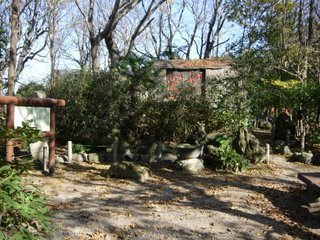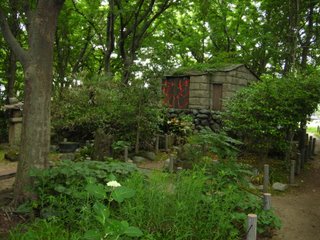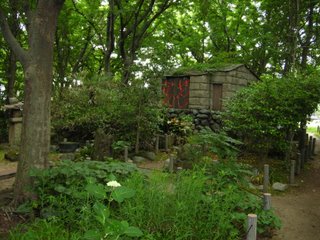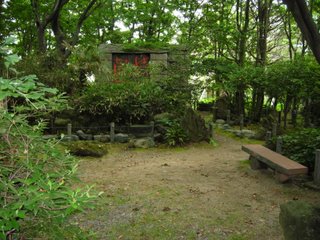The Japanese language is bestrewn with the corpses of terms unable to resist the onslaught of Western loan words. In this space I shall post belated obituary notices of obsolete Japanese. The index will be updated periodically. Contributions are welcome.
辻自動車: (tsujijidousha) literally, "self-moving vehicle at the street corner", better known as taxi
百貨店:(hyakkaten) "shop of a hundred items", now called depaato, from department store
庭球:(teikyuu) "garden ball", now tennis
玉突き(tamatsuki) "the striking of balls", or billiards
白墨(hakuboku) "white India ink", or chalk
受像機(juzoki) "image receiving machine", or television
写真機(shashinki) "reality-copying device", or camera
羽球(ukyuu) "feather ball", or badminton
受話器(juwaki) "conversation-receiving apparatus", or head-phones
配球(haikyuu) the game of "delivering the ball", or volleyball
Tuesday, December 26, 2006
Sunday, December 24, 2006
Tetrapods at Work
A Tetrapod Farm

 Tetrapods are a Showa Era innovation and emblematize the natural catastrophe that is one characteristic of Japan's encounter with the Western World. Donald Richie, longtime expat and insightful translator of Japanese culture, laments the suspension of the "truce" which formerly existed between Japan and Mother Nature. In other words, whereas until the early 20th century the Japanese implicitly acknowledged limitations on their ability-and the desirability thereof-to alter or manipulate Nature, modern Japan admits no such restrictions. For instance, coastal areas subject to extremes of violent weather and which, in times bygone, were wisely deemed off-limits to development, are now depressing (and expensive) examples of capitalism run amok. To protect private property and the infrastructure that makes it possible(as well as to subsidize the local cement people), erosion control measures, chiefly in the form of tetrapods, have been implemented along vast stretches of Japan's coastline. But not even the mighty tetrapod can protect coastal roads and other beachfront development from typhoon-generated storm surge or tidal waves produced by boreal winds, for every year construction crews rush to repair damage inflicted by inclement weather. With the fate of the Earth's ecosystem hanging in the balance, let us hope that Japan returns to her roots and lights the world's way forward to a sustainable co-existence with all of creation.
Tetrapods are a Showa Era innovation and emblematize the natural catastrophe that is one characteristic of Japan's encounter with the Western World. Donald Richie, longtime expat and insightful translator of Japanese culture, laments the suspension of the "truce" which formerly existed between Japan and Mother Nature. In other words, whereas until the early 20th century the Japanese implicitly acknowledged limitations on their ability-and the desirability thereof-to alter or manipulate Nature, modern Japan admits no such restrictions. For instance, coastal areas subject to extremes of violent weather and which, in times bygone, were wisely deemed off-limits to development, are now depressing (and expensive) examples of capitalism run amok. To protect private property and the infrastructure that makes it possible(as well as to subsidize the local cement people), erosion control measures, chiefly in the form of tetrapods, have been implemented along vast stretches of Japan's coastline. But not even the mighty tetrapod can protect coastal roads and other beachfront development from typhoon-generated storm surge or tidal waves produced by boreal winds, for every year construction crews rush to repair damage inflicted by inclement weather. With the fate of the Earth's ecosystem hanging in the balance, let us hope that Japan returns to her roots and lights the world's way forward to a sustainable co-existence with all of creation.
Wednesday, December 20, 2006
Basho and Sora in Niigata



Haiku master Basho and travelling companion Sora left Yamagata for Niigata in early August, 1689. Crossing the Nezu Barrier into Echigo, as Niigata was then known, the two made their way to Kaga Province (Ishikawa Prefecture) via Murakami(8/13), Tsuiji(8/15), Niigata City(8/16), Izumozaki(8/18), Naoetsu(8/20), Takada(8/22), Noh (8/25), and Ichiburi (8/26). The approximate distances (in kilometers) between towns are as follows: Murakami-Tsuiji, 30K; Tsuiji-Niigata, 40K; Niigata-Izumozaki, 60K; Izumozaki-Naoetsu, 30K; Naoetsu-Takada, 10k; Takada-Noh, 15K; Noh-Ichiburi, 30K. Crossing the Ichiburi Barrier, Basho and Sora entered Toyama. Kaga was three days distant.
Tuesday, December 19, 2006
Basho-do Photos



The following photos show Niigata City's Basho Monument, a site commemorating haiku founder Matsuo Basho's visit to the city on 16 August, 1689. During their 奥の細道 pilgrimage, Basho and travelling companion Sora spent little time in Niigata, regarding Echigo Province (as Niigata was then known) as an unavoidable evil to be endured. During the three weeks Basho and Sora followed the treacherous "North Country Road" along the Japan Sea coast, only one poem was composed. On August 18, Basho wrote the following poem at the small port of Izumozaki.
O'er wild ocean spray/ All the way to Sado Isle/ Spreads the Milky Way!
Monday, December 18, 2006
Basho in Niigata



Matsuo Basho, father of the verse form haiku, set off from Edo (Tokyo) in May of 1689 on a pilgrimage to Japan's northern provinces. Accompanied by his disciple Sora, the two covered some 2400 kilometers, mostly on foot, during the ensuing five months. Their peregrinations took them along the Sea of Japan coast later that year, in August . Following the Hokuriku Road southwest from Yamagata Prefecture, the poets made few stops-and penned even fewer haiku- while in Echigo Province, as Niigata was then known. Nevertheless, Basho composed a fine poem in the village of Izumozaki, a small port sixty-odd kilometers from Niigata City. The following translation is by Dorothy Britton.
O'er wild ocean spray/ All the way to Sado Isle/ Spreads the Milky Way!
Though Niigata City itself cannot boast of having inspired the master's muse, the city honors Basho with a fine monument, the Basho-do, located on a promontory overlooking the sea. In clear weather, 佐渡ヶ島, the Sado Isle of Basho's poem, is clearly visible 65 kilometers away.
The photos show Basho-do and its setting in a copse of trees, as well as a nearby view of the Japan Sea. Incidentally, the Basho Memorial is in the vicinity of the site of Megumi Yokota's abduction.
Saturday, December 09, 2006
The Remains of the School Day



A brief discussion of extra-curricular activities shall complete my description of a typical day at Kido JHS. As was remarked in a previous post, club activities constitute a central part of the middle school experience in Japan. In fact, club participation at the 12 Niigata City junior high schools at which I have so far taught has averaged close to 90% of total student enrollment. Kido JHS is no exception. There is a club for nearly every interest and temperament, as the following enumeration demonstrates. For boys as well as girls, there are the art, band, track and field, kendo, basketball, science, and computer clubs. Clubs exclusively for boys include soccer, baseball, table tennis, and soft tennis. For girls, there is volleyball, softball, badminton, or rhythmic gymnastics. Students who participate in extra-curricular activities choose a single club and remain there- or, to paraphrase Mark Twain, put their eggs in a single basket, and proceed to watch it. In Japan, there are no school sports seasons, properly speaking. Therefore, students practice with their club year-round. At Kido JHS, clubs meet until 5:00 PM in winter, but from late spring to late fall, practice ends at 6:00. One result of the emphasis on a single club is that the art and band clubs are, on average, far superior to their American counterparts. Alternatively, I often meet athletically talented students who are highly accomplished in their club sport but who, owing to the limitations of the Japanese system , are remarkably inept at other athletic activities. Kido's gym is shown above. Note the absence of bleachers, which is typical of Japanese school gyms. Spectators use the narrow, second story gallery. One of Kido's two soft tennis courts is also pictured. Soft tennis is a form of tennis that originated in Japan. It is played on a sanded court, with racquets that are slightly smaller than the ordinary. Moreover, the racquets are strung at a tension of about 30 lbs., somewhat less than that for standard racquets. The ball used in soft tennis is approximately the size of a regular ball, minus the felt. Lastly, the net is raised a few inches higher than for the hard-court game. Soft tennis is a rather forgiving form of the sport, a direct result of the string tension, as well as the cushiony quality of the ball. Simply put, a mis-hit will often land in play. While soft tennis is easier to learn than the hard court style, one wonders whether the lack of opportunities for young Japanese to play hard court tennis doesn't partly account for the dearth of Japanese on the pro circuit.
Saturday, December 02, 2006
The School Day- After Lunch

Lunchtime and the noon recess have ended, and the bell announcing the start of fifth period sounds. Three days a week, the fifth class is a followed by a sixth. Five minutes after the final class ends, school cleaning begins. The students clean the school themselves. They are assigned work stations, and in brigades of 5 to 8 students, proceed to sweep, scrub, and otherwise tidy up the school. Excepting the restrooms, which are cleaned at Kido JHS by a professional cleaning firm; the equipment storage rooms, which are seldom cleaned; and the teachers' locker rooms, no corner of the school remains untouched. At some schools (Kido is not among them), the students pick up litter that has collected on the school grounds. All of this is done to the accompaniment of music. A digression is called for here. The jingle played over the PA system during cleaning time is of a genre that would seem to have been created for the express purpose of stimulating the students into a sort of cleaning frenzy. Fast paced and instrumental, the tune is not something one would hear on the radio, or find on a compilation at the local CD shop, or hear anywhere outside of the particular school at which it is played. I have now taught at 12 junior high schools in Niigata City, and no two have played the same cleaning tune. Consider that, and ponder the tremendous business opportunities that await the producers of such recordings. Their cleaning done, the brigades hold short meetings with their supervising teacher to evaluate work performance. After that, it's back to the classroom for the afternoon homeroom meeting. This concluded, it is time for club activities, to participate in which is the primary reason some students attend school at all. A final note: you may be wondering whether there are no janitors at Japanese schools. Janitors there are none, but rather handymen, who maintain the school grounds and make simple repairs. They tend to keep to themselves, being provided their own comfortable room just inside the entrance to the school.
Subscribe to:
Posts (Atom)







